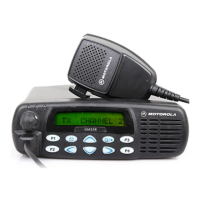2-4 Transmitter Power Amplifier (PA) 60 W
AGC input pin 5 of U1601, reducing its gain and therefore the amount of noise pulses which are
detected and processed.
3.0 Transmitter Power Amplifier (PA) 60 W
The radio’s 60W power amplifier (PA), shown in Figure 2-2, is a three-stage amplifier used to
amplify the output from the VCO to the radio transmit level. The line -up consists of three stages
which utilize LDMOS technology. The first stage is pre-driver (U1401) that is controlled by pin 4 of
PCIC (U1503) via Q1504 and Q1505 (CNTLVLTG). It is followed by driver stage Q1401, and final
stage utilizing two devices (Q1402 and Q1403) connected in parallel. Q1402 and Q1403 are in
direct contact with the heat sink.
To prevent damage to the final stage devices, a safety switch has been installed to prevent the
transmitter from being keyed with the cover removed.
Figure 2-2 Low Band Transmitter Block Diagram
3.1 Power Controlled Stage
The first stage (U1401) is a 20dB gain integrated circuit containing two LDMOS FET amplifier
stages. It amplifies the RF signal from the VCO (TXINJ). The output power of stage U1401 is
controlled by a DC voltage applied to pin 1 from the power control circuit (U1503 pin 4, with
transistor Q1504-5 providing current gain and level-shifting). The control voltage simultaneously
varies the bias of two FET stages within U1401. This biasing point determines the overall gain of
U1401 and therefore its output drive level to Q1401, which in turn controls the output power of the
PA.
Pin Diode
Antenna
Switch
RF Jack
Antenna
Harmonic
Filter
PA-Fina l
Stage
PA
Driver
From VCO
Controlled
Stage
BIAS
To Microprocessor
Temperature
Sense
DC AMP
PASUPLVLTG
(2 Lines)
SPI Bus
TXINJ
Sense
Current
Sense
Current
ASFIC_CMP
PCIC
INT
24
4
29
5
6
BIAS
Power
Power Adjust

